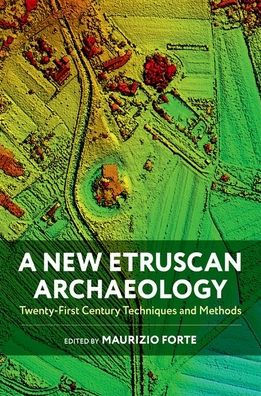A New Etruscan Archaeology: Twenty-First Century Techniques and Methods
A New Etruscan Archaeology provides a comprehensive overview of the latest advancements in archaeological methods and technologies applied to the study of Etruscan civilization. Through vivid illustrations, detailed case studies, and research from twenty-five experts, this book emphasizes the synergy between archaeology and technology. Each chapter illustrates how the integration of digital technologies—such as remote sensing, high resolution 3D imaging, electroencephalography (EEG), and artificial intelligence—can push the field into a new era of innovation and multidisciplinary collaboration.
The volume begins with an exploration of digital technologies used for studying inscriptions, enhancing both accuracy and context, while addressing key epistemological issues. It then delves into urban landscape surveys, highlighting how remote sensing and spatial analysis revolutionize our understanding of Etruscan cityscapes and infrastructures. Advanced remote sensing technologies like ground-penetrating radar (GPR), LiDAR, and magnetometry are showcased for their ability to provide comprehensive data about Etruscan sites.
Cognitive archaeology is explored, particularly the acoustic properties of Etruscan tombs and their implications for understanding funerary rituals, to offer a new perspective on Etruscan cultural practices. Readers are also shown how nanosilica, among other modern materials and advanced techniques, might be used in future conservation practices.
Contributors highlight how environmental and paleoenvironmental studies have provided researchers with a more nuanced understanding of how Etruscans interacted with their landscape and managed their resources. The result is an extensive examination of the ways that science has been used—or might potentially be used in the future—to help us map ancient cities, reconstruct lost artifacts, and even decode the Etruscan language, bringing the past to life with unparalleled clarity and precision.
1147388083
The volume begins with an exploration of digital technologies used for studying inscriptions, enhancing both accuracy and context, while addressing key epistemological issues. It then delves into urban landscape surveys, highlighting how remote sensing and spatial analysis revolutionize our understanding of Etruscan cityscapes and infrastructures. Advanced remote sensing technologies like ground-penetrating radar (GPR), LiDAR, and magnetometry are showcased for their ability to provide comprehensive data about Etruscan sites.
Cognitive archaeology is explored, particularly the acoustic properties of Etruscan tombs and their implications for understanding funerary rituals, to offer a new perspective on Etruscan cultural practices. Readers are also shown how nanosilica, among other modern materials and advanced techniques, might be used in future conservation practices.
Contributors highlight how environmental and paleoenvironmental studies have provided researchers with a more nuanced understanding of how Etruscans interacted with their landscape and managed their resources. The result is an extensive examination of the ways that science has been used—or might potentially be used in the future—to help us map ancient cities, reconstruct lost artifacts, and even decode the Etruscan language, bringing the past to life with unparalleled clarity and precision.
A New Etruscan Archaeology: Twenty-First Century Techniques and Methods
A New Etruscan Archaeology provides a comprehensive overview of the latest advancements in archaeological methods and technologies applied to the study of Etruscan civilization. Through vivid illustrations, detailed case studies, and research from twenty-five experts, this book emphasizes the synergy between archaeology and technology. Each chapter illustrates how the integration of digital technologies—such as remote sensing, high resolution 3D imaging, electroencephalography (EEG), and artificial intelligence—can push the field into a new era of innovation and multidisciplinary collaboration.
The volume begins with an exploration of digital technologies used for studying inscriptions, enhancing both accuracy and context, while addressing key epistemological issues. It then delves into urban landscape surveys, highlighting how remote sensing and spatial analysis revolutionize our understanding of Etruscan cityscapes and infrastructures. Advanced remote sensing technologies like ground-penetrating radar (GPR), LiDAR, and magnetometry are showcased for their ability to provide comprehensive data about Etruscan sites.
Cognitive archaeology is explored, particularly the acoustic properties of Etruscan tombs and their implications for understanding funerary rituals, to offer a new perspective on Etruscan cultural practices. Readers are also shown how nanosilica, among other modern materials and advanced techniques, might be used in future conservation practices.
Contributors highlight how environmental and paleoenvironmental studies have provided researchers with a more nuanced understanding of how Etruscans interacted with their landscape and managed their resources. The result is an extensive examination of the ways that science has been used—or might potentially be used in the future—to help us map ancient cities, reconstruct lost artifacts, and even decode the Etruscan language, bringing the past to life with unparalleled clarity and precision.
The volume begins with an exploration of digital technologies used for studying inscriptions, enhancing both accuracy and context, while addressing key epistemological issues. It then delves into urban landscape surveys, highlighting how remote sensing and spatial analysis revolutionize our understanding of Etruscan cityscapes and infrastructures. Advanced remote sensing technologies like ground-penetrating radar (GPR), LiDAR, and magnetometry are showcased for their ability to provide comprehensive data about Etruscan sites.
Cognitive archaeology is explored, particularly the acoustic properties of Etruscan tombs and their implications for understanding funerary rituals, to offer a new perspective on Etruscan cultural practices. Readers are also shown how nanosilica, among other modern materials and advanced techniques, might be used in future conservation practices.
Contributors highlight how environmental and paleoenvironmental studies have provided researchers with a more nuanced understanding of how Etruscans interacted with their landscape and managed their resources. The result is an extensive examination of the ways that science has been used—or might potentially be used in the future—to help us map ancient cities, reconstruct lost artifacts, and even decode the Etruscan language, bringing the past to life with unparalleled clarity and precision.
99.0
Pre Order
5
1

A New Etruscan Archaeology: Twenty-First Century Techniques and Methods
256
A New Etruscan Archaeology: Twenty-First Century Techniques and Methods
256
99.0
Pre Order

Product Details
| ISBN-13: | 9780197582022 |
|---|---|
| Publisher: | Oxford University Press |
| Publication date: | 08/14/2025 |
| Pages: | 256 |
| Product dimensions: | 6.50(w) x 1.50(h) x 9.50(d) |
About the Author
From the B&N Reads Blog
